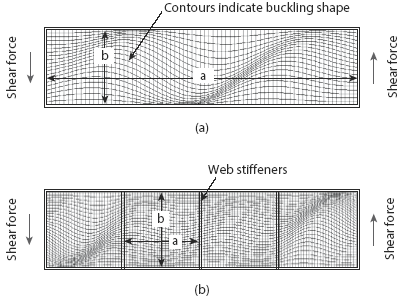Related Resources: calculators
Shear Buckling of Unstiffened Plates Formula and Calculator
Shear Buckling of Unstiffened Plates Formula and Calculator
Plate girder webs are usually very slender and fail by shear buckling rather than yielding. To control this, intermediate web stiffeners are used to raise the shear strength, as illustrated in Figure 1.
Membership (Premium) required to access calculator
Eq. 1
For steel, Poisson’s ratio ν = 0.3 and Young’s modulus E = 210,000 N/mm2 and Equation 1 becomes
Eq. 2
For the most common situation of plates simply supported on all four edges, the buckling coefficient is
Eq. 3
(SeeCompression Buckling in Unstiffened Plates Formula and Calculator webpage Figure 2, for K values)

Figure 1 Illustration of shear buckling for a plate girder web. (a) No intermediate web stiffeners and
(b) with intermediate stiffeners.
where a is the length and b is the width as illustrated in Figure 1. As stated previously, plates bounded on four sides by flanges and web stiffeners have a post-buckling reserve of strength due to a phenomenon called tension field action. This means that the elastic critical shear stress generally provides a conservative estimate of strength, despite imperfections, such as weld shrinkage stresses and lack of straightness. For this reason, the design stress can be taken as either the elastic critical shear stress or the yield shear stress, whichever is less. The shear stress, which will cause first yielding, is
Eq. 4
The design value of shear stress (τRd) is the lesser of either τcr or τy, i.e.,
Eq. 5
and the design shear strength (VRd) is approximately given by
Eq. 6
where
τcr = is the elastic critical buckling shear stress.
ν is Poisson’s ratio.
E is Young’s modulus.
t is the plate thickness.
a is the plate length.
E is the Modulus of elasticity
k is the buckling coefficient.
b is the plate width (height) (see Figure 2).
t is the plate thickness.
Source:
- Structural Design First Principles, Michael Byfield
Related
- Compression Buckling in Unstiffened Plates Formula and Calculator
- Steel Beam and Column Analysis and Code Check Calculator
- Buckling of Flat Plates Excel Calculator
- Buckling of Foam Core Sandwich Panels Excel Calculator
- Plate Shear Buckling Stress Formulae and Calculator
- Nonlinear Buckling of Cylinder under External Lateral Pressure
- Buckling of Curved Plates
- Ideal Pinned Column Buckling Equation and Calculation, Euler's Formula
- Buckling of Cylinder Plate Equations and Calculation
- Buckling of Uncored Composite Panels Excel Calculator
- Rankine Gordon Equation
- Buckling of a rectangular column on the basis of Murnaghan's formula for strain energy
- Bar Restrained Against Lengthwise Thermal Expansion Calculator and Equations
- Bar Restrained Against Lengthwise Thermal Expansion Calculator and Equations
- Bar Restrained Against One End and Gap on Other Stress and Force Calculator and Equations
- Bar Restrained With Spring Uniform Heat Applied Calculator
- Two Bars At Different Temperatures Stress Calculator and Equations
- Lateral Torsional Buckling Formulae and Calculator
- Buckling Rectangular Column